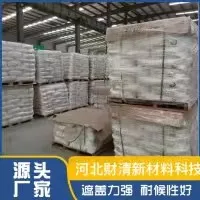
May . 06, 2025 15:19 Back to list
Titanium Dioxide: A Closer Look at Its Types and Industrial Value
Titanium dioxide, a widely used and crucial chemical product, plays a significant role in numerous industries around the world. It is highly valued for its excellent properties such as strong cold resistance, high dispersibility, and remarkable covering power. In the global chemical market, especially in the field of pigments and additives, titanium dioxide holds a prominent position. To better understand this versatile material, it is essential to explore its classification.

Rutile Titanium Dioxide: A Dominant Force in the Market
Rutile titanium dioxide, like the CR - 930 series offered by Hebei Caiqing Material Technology Co., Ltd., is one of the two main types of titanium dioxide. Rutile has a more stable crystal structure compared to other forms. This stability endows it with several outstanding characteristics. Firstly, it has a higher refractive index, which means it can scatter light more effectively. As a result, products containing rutile titanium dioxide exhibit enhanced whiteness and opacity. In the coatings industry, for example, rutile titanium dioxide is widely used. It can provide coatings with excellent hiding power, ensuring that the underlying surfaces are completely covered, whether it is for architectural coatings on buildings or automotive coatings.
In the paper industry, it helps to improve the brightness and opacity of paper, making the printed text and images more distinct. In the rubber and tire industries, rutile titanium dioxide not only contributes to the whiteness of the products but also enhances their durability and resistance to environmental factors. Its strong cold resistance makes it suitable for use in products that may be exposed to low - temperature conditions, such as tires in cold regions.
Anatase Titanium Dioxide: A Versatile Option
Anatase titanium dioxide, such as the BA01 - 01 and CA100 series, is another important classification. Anatase has a different crystal structure from rutile, which leads to some differences in properties. It generally has a finer particle size, which gives it better dispersibility in certain applications. In the paint industry, anatase titanium dioxide is often used. Due to its good dispersibility, it can be evenly distributed in the paint, resulting in a more uniform color and finish.
In the ceramics industry, anatase titanium dioxide can be used to modify the properties of ceramic materials. It can improve the whiteness and luster of ceramics, making them more aesthetically pleasing. Although anatase titanium dioxide may have a slightly lower refractive index than rutile in some cases, its unique properties make it an ideal choice for specific applications where fine particle size and good dispersibility are more crucial.
In conclusion, the classification of titanium dioxide into rutile and anatase types provides manufacturers and industries with a wide range of options to meet their specific needs. Each type has its own set of advantages, and their applications span across multiple industries, from coatings and paper to rubber, paint, and ceramics. As companies like Hebei Caiqing Material Technology Co., Ltd. continue to invest in research and development, the performance of these two types of titanium dioxide is expected to be further optimized, opening up more possibilities for their use in various fields.
-
Application of Titanium Dioxide 2195 in Water Purification
NewsNov.14,2025
-
What are the global market trends of Titanox titanium dioxide in recent years
NewsNov.14,2025
-
Effect of particle size distribution on the optical properties of R996 TiO2
NewsNov.14,2025
-
Latest Technological Innovations in Rutile Titanium Dioxide Manufacturing
NewsNov.14,2025
-
Compatibility of Titanium Dioxide Concrete Pigment with Different Concrete Admixtures
NewsNov.14,2025
-
Environmental Impact of Titanium Dioxide Pigment Manufacturing and Mitigation Measures
NewsNov.14,2025
